- RadioActive
- Moderator
 Offline
Offline
FCC Gives OK To "Geocasting" Technology - But There's A Catch
It's called Geocasting, ZoneCasting or Maxxcasting, among other names. It allows FM radio stations to set up a small extremely low powered transmitter to boost a station's signal in a fringe area on the same frequency. (I don't believe it's even on the radar in Canada, but if it works there, it could conceivably come here.)
The idea is not only to improve reception in areas within a station's contours, but to actually allow owners to sell separate advertising depending on their geographic location. So a J.C. Penney downtown could have one spot, while a Wal-Mart uptown could be reaching a different audience at the exact same time on the same station.
But there's a catch. Fears of interference continue, which may be one reason why the FCC in the U.S. has stipulated that it can only be used for three minutes an hour, as a test phase. Whether it's ultimately worth it or not remains to be seen and heard.
Some examples of a few stations' plans include:
"WRBJ-FM in Jackson, Miss., is an urban format station owned by Roberts Broadcasting that participated in testing the technology. “The station will utilize ZoneCasting to offer affordable advertising rates to smaller, minority-owned businesses and provide targeted content for Jackson State University,” GBS wrote.
KLCY(FM) in Vernal, Utah, a country station owned by Ashley Communications, will use ZoneCasting to deliver content specific to a large Ute Indian Tribe reservation, “supported by strong community interest and funding from Ute leadership.”
KADD(FM) in Las Vegas is operated by Radio Activo. It will target high-density Hispanic areas in Las Vegas and Washington County, Utah."
So how many small sticks are possible?
"The FCC will allow stations to apply for up to 25 boosters, though most deployments are expected to involve far fewer."
Will it work or expand? We'll find out three minutes at a time in the near future.
The entire process is explained in this article about how it all might work.
- RadioActive
- Moderator
 Offline
Offline
Re: FCC Gives OK To "Geocasting" Technology - But There's A Catch
I honestly wonder if they could do this in a border market like Buffalo, where a signal could conceivably leak over into Canada, causing interference on an already very crowded FM radio dial.
- •
- Radiowiz
- Member
 Offline
Offline 
Re: FCC Gives OK To "Geocasting" Technology - But There's A Catch
RadioActive wrote:
I honestly wonder if they could do this in a border market like Buffalo, where a signal could conceivably leak over into Canada, causing interference on an already very crowded FM radio dial.
One station that would have been good for this is WTSS, but Star 102 was sold to a business that does not run ads.
The next best possibility would be WBUF, since that is supposed to be a strong signal.
- rk12
- Member
 Offline
Offline
Re: FCC Gives OK To "Geocasting" Technology - But There's A Catch
This would work much better if the US switched to DAB.
- paterson1
- Member
 Offline
Offline
Re: FCC Gives OK To "Geocasting" Technology - But There's A Catch
Newspapers tried this over a decade ago with their websites. I am not sure how successful this was. The transmitters for geocasting will be so low power and limited there wouldn't be much chance of the signal going across the border. We are talking signals that conceivably will only cover a few miles or city blocks clearly. Basically these low powered transmitters are permitted to serve the immediate area and nothing else.
I take it that stations would also be allowed to have a few minutes of original programming or advertising on existing rebroadcasters? I like the way the article says that stations could have local newscasts or programming for a few minutes every hour to the immediate area. That is assuming the main station has any news or local programming in the first place. For music stations this will be used for advertising only.
- pinto
- Member
 Offline
Offline
Re: FCC Gives OK To "Geocasting" Technology - But There's A Catch
Stingray has tried this, got smacked down by you know who...
- RadioAaron
- Member
 Online!
Online!
Re: FCC Gives OK To "Geocasting" Technology - But There's A Catch
pinto wrote:
Stingray has tried this, got smacked down by you know who...
Yeah, 93.5 would have been the perfect use for this.
If it ever does get approved here, it will be used solely for countering signal deficiencies; the separate commercials are unnecessary and add complication that stations frankly aren't staffed to pull off.
- rk12
- Member
 Offline
Offline
Re: FCC Gives OK To "Geocasting" Technology - But There's A Catch
Can you imagine driving on edge of low power transmitter and have it cut in and out with main transmitter with a different commercial.You would likely change to different channel.Most radio listening is done in cars, broadcasters need to think moving reception.This can only work if there is no signal from main transmitter at all,like behind a mountain.
- RadioAaron
- Member
 Online!
Online!
Re: FCC Gives OK To "Geocasting" Technology - But There's A Catch
rk12 wrote:
Can you imagine driving on edge of low power transmitter and have it cut in and out with main transmitter with a different commercial.You would likely change to different channel.Most radio listening is done in cars, broadcasters need to think moving reception.This can only work if there is no signal from main transmitter at all,like behind a mountain.
If you make it a true simulcast, it can work quite smoothly where the signals overlap. That's the main advantage, and what Stingray wanted to do for 93.5
 1 of 1
1 of 1